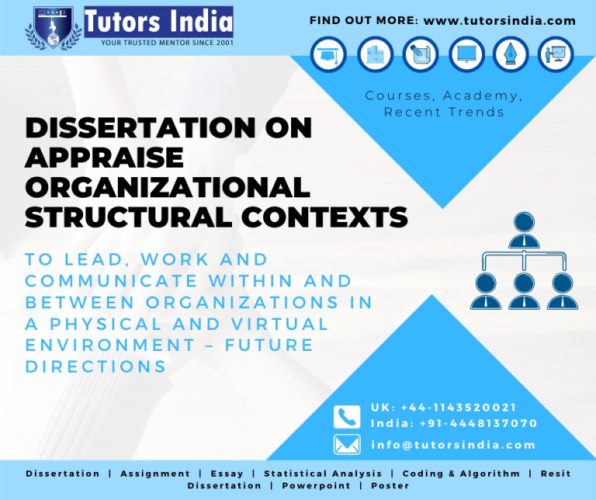Dissertation On Appraise Organizational Structural Contexts To Lead, Work And Communicate Within And Between Organizations In A Physical And Virtual Environment – Future Directions
In Brief
- You will find the best dissertation research areas/topics for future researchers enrolled in Engineering & Technology.
- In order to identify future research topics, we have reviewed the organizational structural context. (recent peer-reviewed studies).
- First, this article gives you an idea about how to action plan for attaining the goals of the organization.
- Then, this articles you will know how to communicate within and between organizations.

Physical environments are important in promoting and limiting organizational behavior. The construction and arrangement of machinery, workspaces, environmental controls, and facilities influences everything from the effective manufacturing of computer chips to the research and development of new flavors of potato chips. However, since physical environments tend to include large objects, relatively fixed and long-lasting structures and costly installations, design decisions need to be made carefully and provide a thorough understanding of the effects of physical environments on organizations and their members (Elsbach & Pratt, 2007).
You will find the best dissertation for future researchers enrolled in Engineering & technology. These topics are researched in-depth at the University of Glasgow, UK, Sun Yat-sen University, University of St Andrews and many more.
There are certain criteria for setting up an atmosphere that can facilitate virtual teaming successfully including: providing opportunities for interaction that can replace those encountered in a traditional team setting; providing feedback to team members on each other’s activities, availability and job progress; providing support to different work modes; and providing an environment for team members. Virtuality influences the form of management systems that are set up to deal with virtual teams when they start deploying. Digital team leaders perform a variety of functions within the organization, mainly integrating team members into one cohesive unit, tracking and maintaining ongoing team performance continuously. Strengthening project goals while ensuring team roles are not in conflict with other commitments of team members is also identified as key.
It is also seen as imperative to establish clear procedures for conflict resolution in order to avoid minor disagreements between team members, as is the need for virtual team managers to visit dispersed team members to provide evaluations and maintain contact. It is also crucial that managers clearly define the role of the virtual team in the context of the greater mission of the organization, including the limits of team scope and responsibility (Chaudhari, 2010).
It is possible to categorize structural factors into formalization, specialization, hierarchy and authority, centralization and professionalism. The key contextual factors for organizational types are: size of the organization, technology, environment, intent, mission, objectives, strategy and organizational culture.There is also engineering dissertation writing help for computer science with best assistance for physical and virtual environment.
Download our internationalization computer science related Reference book papers such as tutorials, proprietary materials, research projects and many more @ tutorsindia.com/academy/books
For organizations, formalization can be represented as a number of written documents, such as specified procedures, laws, regulations, job descriptions, and policy manuals. All those documents describe organizational activities and behaviour.
The degree to which duties are partitioned into separate jobs is known as specialization. Each employee performs only a small amount of similar activities and tasks that are in their job description when the specialization is high. Also, get assignment writing guidance on organizational structural contexts in a high quality.
Tutors India has vast experience in developing organizational structural context for engineering students pursuing in UK. Order Now
Hierarchy of authority can be defined as a number of levels of organization’s management. It can also be defined as a control period, number of employees under the control of one manager or overseer. The hierarchy appears to be shorter if the boss manages a greater number of employees. When a limited number of employees are managed by the boss the hierarchy appears to be tall.
Centralization refers to the level of hierarchy that has the power to make a decision. Where decision-making process is at the highest level, organization is centralized. When decision-making process is possible and occurs at lower levels of hierarchy, then the centralization is a week or the organization is decentralized.
Professionalism can be defined as education level, as well as additional education and training. It is calculated by number of years of education for workers.
Contextual factors can be categorized into: organizational size, technology, environment, strategy, purpose, mission, goals and organizational culture.
Organizational size may be defined as a magnitude expressed in number of organizational employees. Total sales or total assets can be measured here.
Technology can be defined as instruments, techniques, and actions used to transform inputs into outputs. It concerns how the organization actually manufactures the products and services, and includes things like information system, flexible manufacturing, etc.
Environment contains all things outside the organization’s boundaries. Environment is a component that organization cannot control, but it affects the organization. It can be represented as an industry we do business, government, clients, suppliers and financial institutions in.
Organizational goals strategy and mission are elements that determine the organizational intent of operation. Strategy is described as action plan for attaining the goals of the organization.
The culture of an organization can be defined as a set of shared organizational values, beliefs, understandings and norms. Organizational culture is informal and it’s not written but it can be observed in company stories, ceremonies, dress code and employee engagement (Detelj et al., 2009).
According to Balance Theory, the effects of the work system on the individual are assumed to be mediated by the stress load that is both physical and psychological. These effects have influences on the quality of working life, performance, strain and health.
Environment: Ergonomists have identified various aspects of the physical environment as stressors for work, including noise, lighting, temperature, air quality and layout of workplaces.
Task: Many of the so-called psychosocial work factors fall within the task element: job requirements (e.g. perceived quantitative workload, work pressure, cognitive demands), job content (e.g. challenge, repetitiveness), machine-pacing and job-control.
In order to identify the sources for law, we have reviewed the organizational structural context (recent peer-reviewed topics) on computer science.
Technology: Failure to use the technology leads to poor motivation, tension and decreased performance. Anxiety over job loss due to technology substitution decreases motivation and raises tension. On the other hand, when new technology is properly applied, it can improve work quality and use of skills, resulting in increased productivity and efficiency with reduced stress. The tools and technology’s physical properties can place physiological loads on the employee.
Organizational factors: The organizational sense in which job activities are performed often has factors affecting the motivation, stress and efficiency of employees. The way staff are introduced to new technology or some other transition, and the organizational support they receive — such as preparation and time to acclimatize was related to stress and success (Carayon & Smith, 2000).
Individual: The physiological and psychological responses that the preceding elements of the work system model should produce are decided by a number of personal factors. These include temperament, physical health status, skills and abilities, physical conditioning, anthropometrics, prior experience and learning, motivations, aspirations and desires, but are not limited to.
Therefore, it can be seen that the organizational factors play a crucial role in fulfilling the need for fluid communication both in internally and with the environment, regardless of it being physical and virtual. However, with the incorporation of these factors the flexibility in managing and communication can be increased by generating useful knowledge at each level of the organization. Also, when organizations utilizes technologies, employees who work in virtual environments avail greater benefit in terms of sustainability and productivity than the employees working in organizations with physical environments. Further, these organizational factors are significantly important for enhancing the overall productivity of both the physical and virtual organizations.
References
- Carayon, P. & Smith, M.J. (2000). Work organization and ergonomics. Applied Ergonomics. [Online]. 31 (6). pp. 649–662. Available from: https://linkinghub.elsevier.com/retrieve/pii/S0003687000000405.
- Chaudhari, D.A. (2010). Benefits and challenges of Virtual Organizations. [Online]. Available from: https://www.researchgate.net/publication/281079578_Benefits_and_challenges_of_Virtual_Organizations.
- Detelj, K., Čalopa, M. & Pihir, I. (2009). Impact of ICT on the structural and contextual organizational elements: Case of the Varaždin County. Journal of Information and Organizational Sciences. [Online]. 33. Available from: https://www.researchgate.net/publication/40624944_Impact_of_ICT_on_the_structural_and_contextual_organizational_elements_Case_of_the_Varazdin_County/citation/download.
- Elsbach, K.D. & Pratt, M.G. (2007). 4 The Physical Environment in Organizations. The Academy of Management Annals. [Online]. 1 (1). pp. 181–224. Available from: http://annals.aom.org/lookup/doi/10.1080/078559809.

 Previous Post
Previous Post Next Post
Next Post